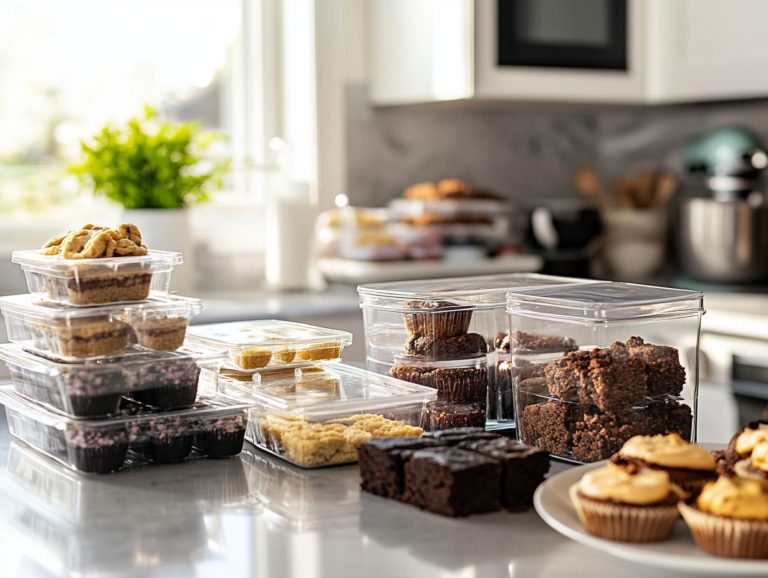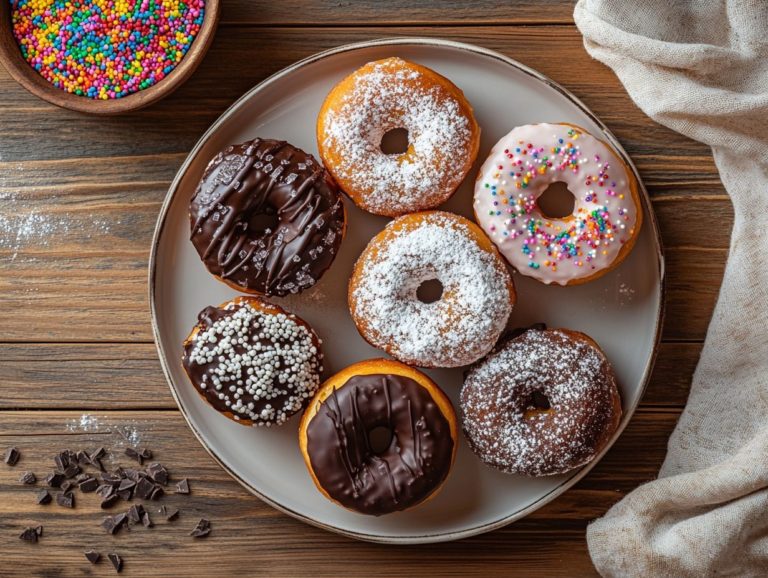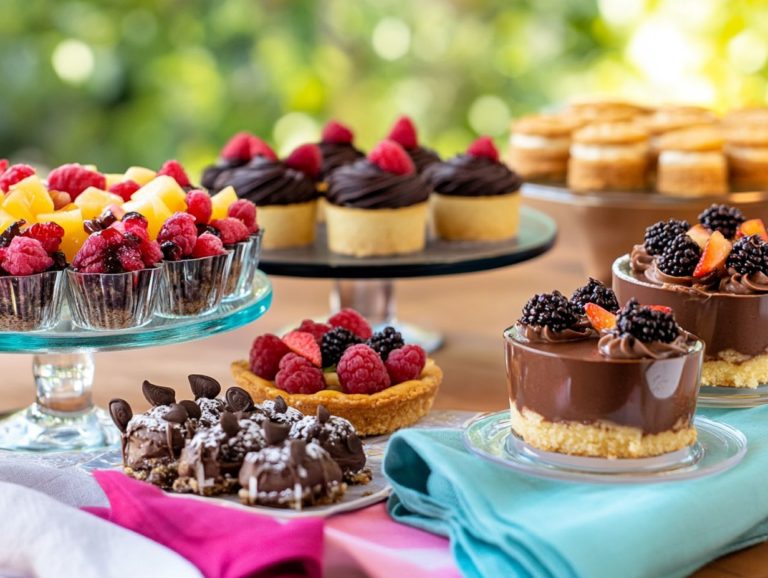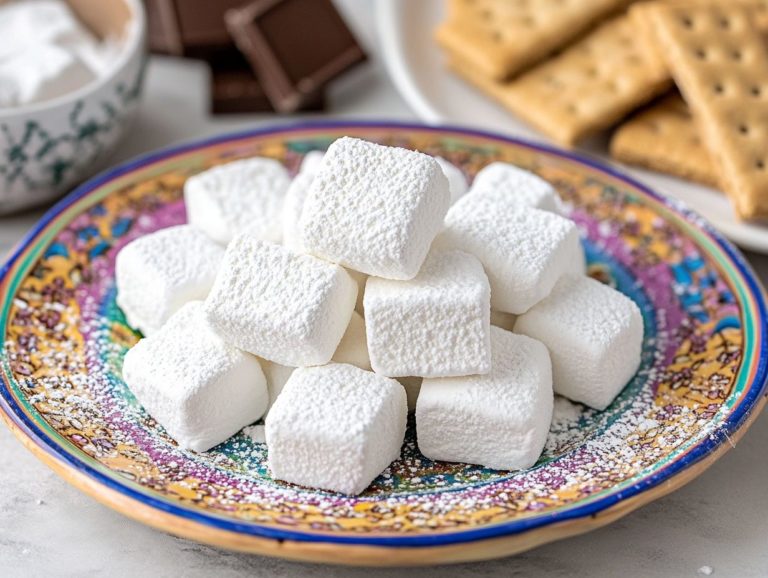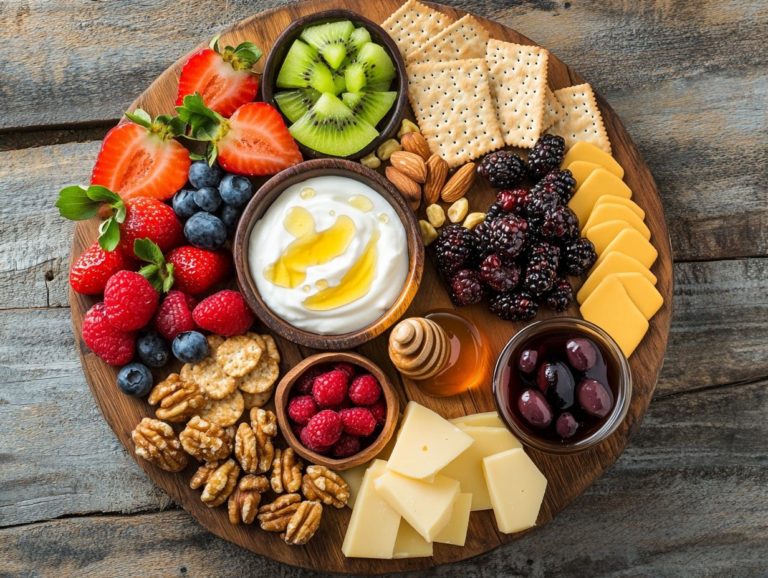How to Create a Gluten-Free Dessert Table
Navigating the world of dietary restrictions may seem daunting, but embracing a gluten-free diet doesn t require you to forgo the joy of indulging in delicious gluten-free desserts.
This guide delves into what a gluten-free diet truly involves and how you can curate an enticing dessert table that delights every palate. You ll learn about essential ingredients, delicious gluten-free dessert recipes, and how to plan and execute the perfect setup, complete with tips and tricks to ensure your dessert offerings are both safe and scrumptious.
Whether you re hosting a special event like a wedding reception or family gathering, or simply craving a sweet treat, a wealth of delectable options awaits you!
Contents
- Key Takeaways:
- What is a Gluten-Free Diet?
- What is a Gluten-Free Dessert Table?
- What Are Some Common Ingredients in Gluten-Free Desserts?
- Why Create a Gluten-Free Dessert Table?
- Who Can Benefit from a Gluten-Free Dessert Table?
- What Are the Benefits of a Gluten-Free Diet?
- How to Create a Gluten-Free Dessert Table?
- 2. Keep Gluten-Free Desserts Separate from Non-Gluten-Free Desserts
- 3. Offer a Variety of Flavors and Options
- 4. Consider Cross-Contamination and Allergies
- Frequently Asked Questions
- What is a gluten-free dessert table?
- How do I start planning for a gluten-free dessert table?
- What types of desserts can I include in a gluten-free dessert table?
- Where can I find gluten-free ingredients for my desserts?
- How can I make sure my gluten-free dessert table is safe for those with celiac disease?
- Can I make my whole dessert table gluten-free?
Key Takeaways:
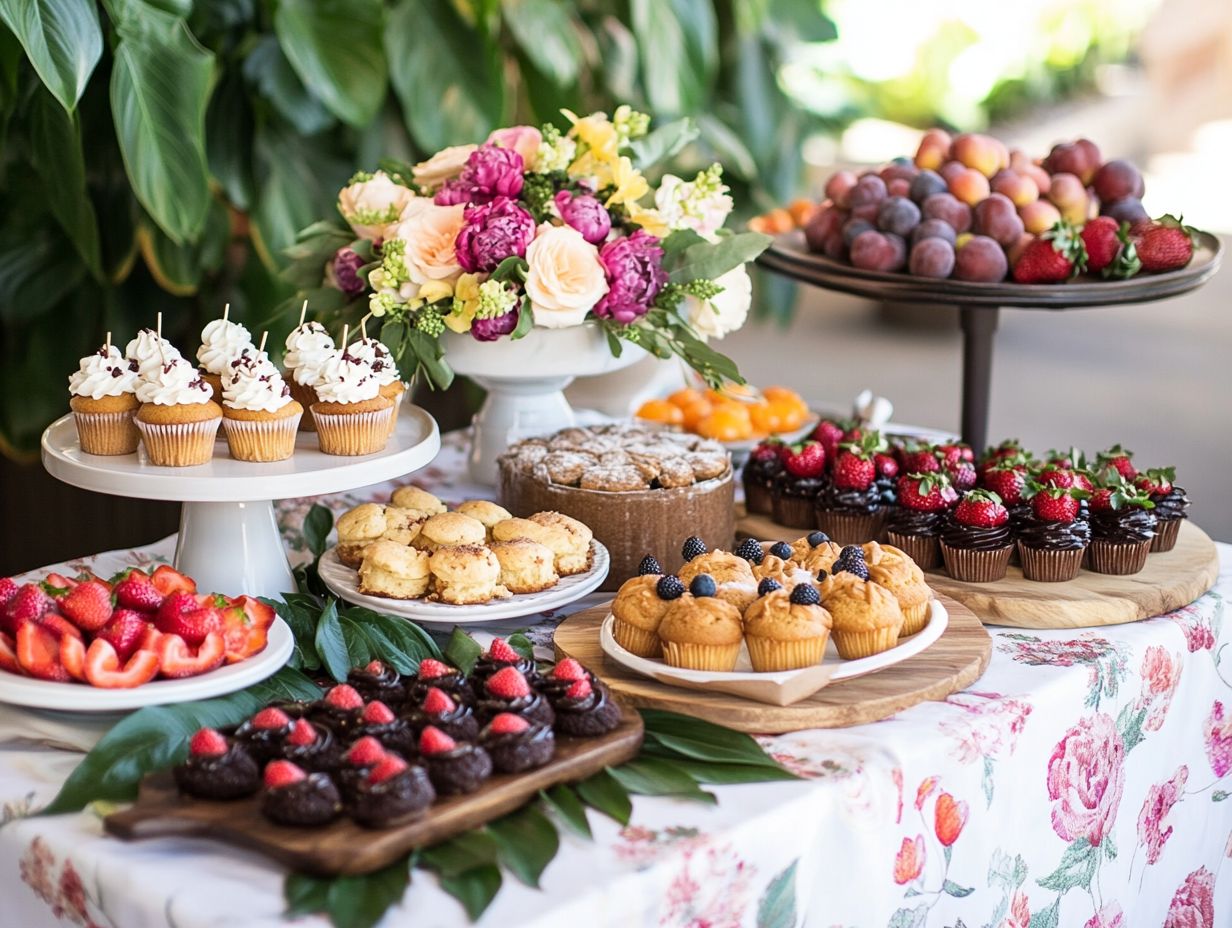
- Understand what a gluten-free diet is and why it is important for some people to follow.
- A gluten-free dessert table allows those with dietary restrictions to enjoy delicious treats.
- Successful gluten-free dessert tables require careful planning, labeling ingredients, and considering cross-contamination and allergies.
What is a Gluten-Free Diet?
Understanding the fundamentals behind a gluten-free diet allows you to create sumptuous and safe dessert options for those with dietary restrictions.
A gluten-free diet is a nutritional strategy that excludes gluten, the pesky protein found in wheat, barley, and rye. This approach is particularly crucial if you have celiac disease, a serious condition that affects how your body processes gluten, or gluten sensitivity, which causes discomfort when gluten is consumed.
You can indulge in a fantastic variety of naturally gluten-free foods such as fruits, vegetables, meats, and gluten-free grains like quinoa and rice, opening the door to a world of diverse meal options!
Gluten-free desserts are not just a trend; they are delicious alternatives that let you enjoy sweet treats without compromising on flavor. Consider options like peanut butter cookies or magic cookie bars made with gluten-free ingredients.
By sticking to a gluten-free regimen, you can effectively alleviate symptoms associated with gluten-related disorders, leading to an overall enhancement in your health and well-being. Embracing this dietary choice means making a lifestyle shift that invites you to explore the plethora of gluten-free products now readily available at grocery stores.
Think gluten-free pasta, bread, and baked goods these items support those with specific health concerns and offer you, whether gluten-sensitive or not, a chance to venture into exciting new culinary territories. Gluten-free cake options are more delicious and accessible than ever before!
Incorporating gluten-free options into your meal planning is essential for maintaining nutritional balance, ensuring that your dining experiences remain enjoyable and satisfying. This includes creating festive desserts like gluten-free cake or easy pumpkin spice treats for special occasions.
What is a Gluten-Free Dessert Table?
Creating a vibrant dessert board filled with gluten-free options showcases your commitment to inclusivity and delicious dining.
A gluten-free dessert table is a thoughtfully curated showcase of treats completely free from gluten, making it the perfect choice for occasions like wedding receptions, family gatherings, or holiday celebrations.
This delightful spread emphasizes an array of delicious and visually appealing desserts, from tempting cookie bars to luscious mini cheesecake bites and indulgent chocolate confections. For an added touch, use serving trays to display the desserts beautifully. It caters to gluten-sensitive guests while ensuring that everyone can savor a sweet ending to their meal.
The secret to a truly successful gluten-free dessert table lies in the diverse array of flavors and textures, designed to enchant every palate in attendance.
What Are Some Common Ingredients in Gluten-Free Desserts?
Common ingredients in gluten-free desserts offer a great variety of alternatives that enable you to whip up delicious treats without relying on traditional flour perfect for anyone embracing a gluten-free lifestyle. For instance, using sweetened condensed milk can elevate your dessert recipes with a rich, indulgent touch. Meanwhile, almond flour provides a stellar base for creations like peanut butter cookies or magic cookie bars. Don’t forget to use a proper baking dish to get the best results.
Don t underestimate the power of chocolate chips and chopped raw pecans; they can truly enhance flavor profiles, adding delightful textures and tastes to your cookies and other sweet confections. Incorporating these into a cookie base can transform a simple recipe into a gourmet treat.
Plus these essentials, consider incorporating coconut flour and gluten-free oats into your baking repertoire. Coconut flour is a gluten-free flour made from ground coconuts and is wonderfully absorbent; it requires a bit more liquid in your recipes. However, it brings a unique, mild sweetness that s perfect for cakes and muffins. Meanwhile, gluten-free oats not only add heartiness to desserts like oatmeal raisin cookies but also serve as an excellent base for homemade granola bars. When coupled with ingredients like nut butter and fresh fruit, these recipes are simply irresistible.
Recipes such as flourless chocolate cake or coconut macaroons beautifully showcase how these alternative ingredients can create decadent and satisfying desserts. They prove that gluten-free baking can be just as enjoyable and flavorful as its traditional counterparts. Other ideas include vibrant desserts like peach cobbler or Eton mess, showcasing an exciting array of flavors and textures.
Why Create a Gluten-Free Dessert Table?
Creating a gluten-free dessert table is an exciting way to accommodate diverse dietary needs, ensuring that every guest can savor sweet treats without compromising their health. Whether it s a wedding reception or a family gathering, a gluten-free dessert table presents an array of festive options. It invites everyone to indulge in delicious desserts made with seasonal fruits and other gluten-free ingredients. Also, consider featuring no-flour recipes like pavlova or homemade peppermint bark to add a unique touch.
This strategy makes the experience better for your guests and shows your commitment to inclusivity and consideration for dietary restrictions.
Who Can Benefit from a Gluten-Free Dessert Table?
A gluten-free dessert table is a true delight for individuals with celiac disease or gluten sensitivity, offering them safe and delicious options tailored to their dietary needs. Even those who are simply in search of healthier dessert alternatives can indulge in a delightful variety of treats available, like rich chocolate mousse and creamy banana pudding, all crafted from gluten-free ingredients.
By including these options, you can ensure that every guest feels welcomed and involved in the joyous occasion. For a personal touch, serve homemade vanilla pudding and rich chocolate mousse in attractive serving trays.
But the appeal of gluten-free desserts extends far beyond those with specific medical conditions. Many followers of popular dietary trends, such as paleo or keto, frequently find gluten-free desserts to be a perfect fit, as many align seamlessly with their nutritional objectives. With a plethora of gluten-free cookies, cakes, and puddings readily available, creating an inclusive dessert experience that caters to diverse tastes and dietary requirements has never been easier.
Why not experiment with these delightful recipes at your next gathering? Consider adding dessert ideas like Eton mess or banana pudding to your repertoire.
What Are the Benefits of a Gluten-Free Diet?
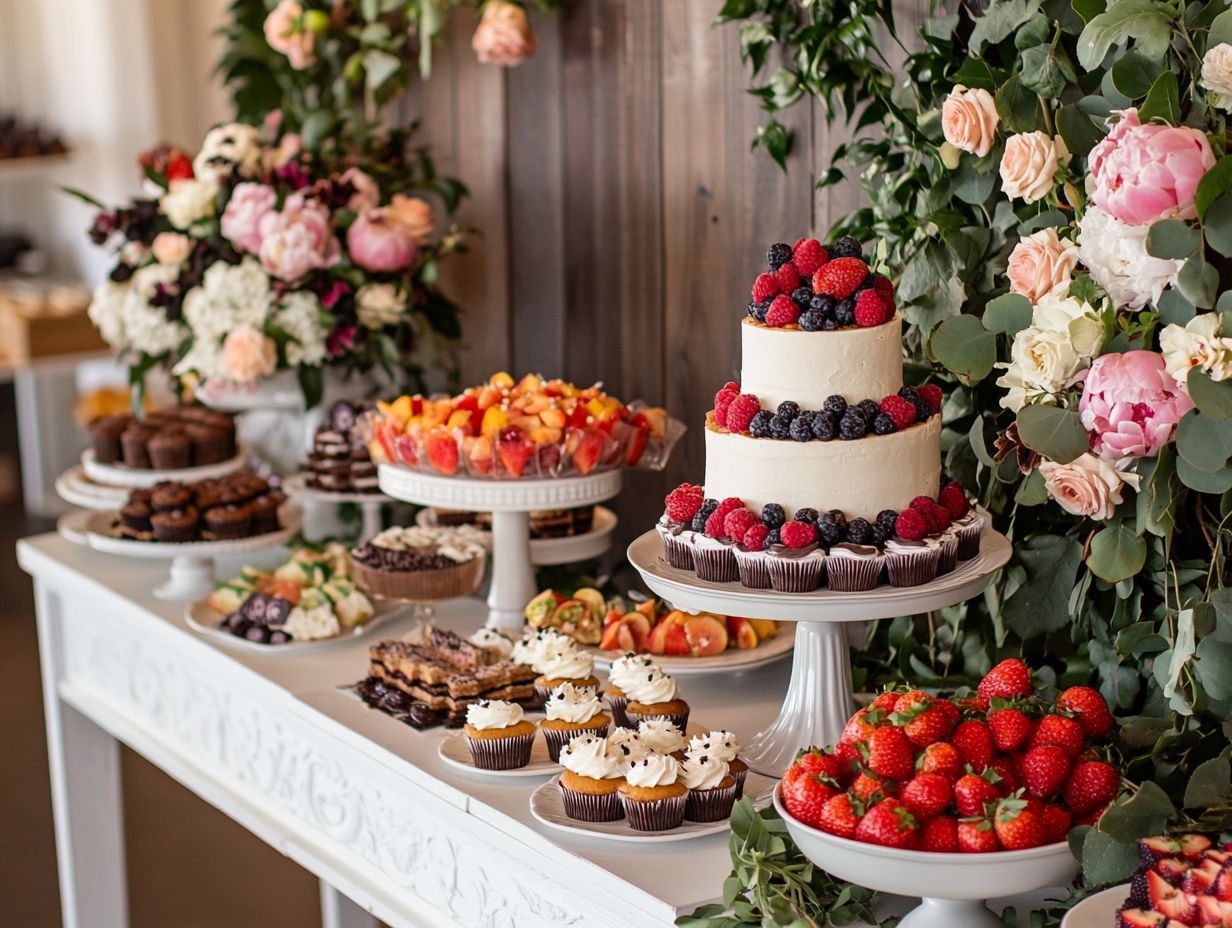
The advantages of adopting a gluten-free diet go far beyond merely steering clear of gluten. It can profoundly enhance your digestive health, particularly if you have gluten-related disorders, leading to elevated energy levels and a greater sense of overall well-being.
By incorporating a variety of healthy dessert options think delightful fresh fruit or luscious homemade vanilla pudding you can provide yourself with nutritious alternatives to traditional sweets. This not only helps you maintain a balanced diet but also invites you to explore new culinary delights.
For instance, a serving of Eton mess a dessert made of meringue, whipped cream, and fresh fruit or a slice of gluten-free cake can be both satisfying and health-conscious.
For many, transitioning to a gluten-free lifestyle can diminish bloating, gas, and other digestive discomforts that often come with gluten consumption. This dietary shift may leave you feeling more vibrant throughout the day as your body becomes increasingly adept at absorbing essential nutrients.
Embracing gluten-free grains like quinoa, brown rice, and millet adds diversity to your meals while introducing exciting textures and flavors. Don’t miss out on the fun of experimenting with ingredients like fresh fruit and nuts, which can elevate your gluten-free baking.
Gluten-free snacks, such as energy bars crafted from nuts and seeds or tempting coconut macaroons, can satisfy your sweet cravings while delivering essential nutrients. This transforms indulgences into health-promoting choices.
How to Create a Gluten-Free Dessert Table?
Crafting a gluten-free dessert table is a creative project that guarantees tasty flavors and safety for every guest. Imagine the delight of your guests as it transforms into a show-stopping centerpiece for any event.
Begin by choosing a theme that aligns seamlessly with the occasion, whether it s an elegant wedding reception or a cozy family gathering. Then, embark on a journey of research to discover gluten-free recipes that showcase an array of textures and flavors think rich chocolate ganache, indulgent homemade peppermint bark, Rocky Mountains (a type of dessert bar), and refreshing fruit-inspired delights.
This meticulous planning stage is crucial for assembling a desser board that captivates the eye and delights the palate.
1. Choose a Theme
Choosing a theme is the first and most crucial step in crafting your gluten-free dessert table, as it sets the tone for the entire presentation. Whether you decide on a vibrant seasonal theme featuring fresh fruits or a cozy holiday spread showcasing festive delights, having a clear vision will streamline your selection of desserts and decorative elements.
This attention to detail not only elevates the overall aesthetic but also delights your guests with a cohesive experience. Consider including easy-to-make desserts like whipped cream-topped pavlova or Eton mess for a delightful finish.
For example, envision a spring-themed dessert table adorned with delicate pastel colors and floral accents, showcasing light and airy gluten-free cakes topped with edible flowers. On the flip side, a Halloween-inspired spread could come to life with spooky treats like gluten-free chocolate cupcakes crowned with ghostly meringue toppers and pumpkin-shaped cookies.
For a more formal event like a wedding reception, consider a dessert board with mini cheesecake bites and homemade vanilla pudding.
Seasonal themes can also guide your flavor choices, ensuring that your desserts not only look spectacular but also capture the essence of the season. By thoughtfully blending decorations with your dessert selections through these themes, you’ll create an inviting and visually captivating display that resonates with all your attendees.
2. Research and Plan Gluten-Free Recipes
Researching and planning gluten-free dessert recipes is crucial for ensuring that your dessert offerings are both delectable and safe for guests with dietary restrictions. Focus on discovering a variety of cookie recipes, from classic peanut butter cookies to indulgent magic cookie bars.
Explore more sophisticated delights like Eton mess or chocolate mousse. Incorporate seasonal fruits and try easy pumpkin spice recipes for festive occasions. This diversity caters to various preferences and highlights the incredible versatility of gluten-free baking.
By incorporating popular ingredients such as almond flour, coconut flour, or gluten-free oats, you can create delightful gluten-free desserts that everyone will love. Consider using nut butter and chopped raw pecans to enhance flavor.
Try your hand at a flourless chocolate cake that will wow your guests! You can also make a cheesecake with a gluten-free crust to truly tantalize the taste buds. Don’t forget to try making homemade peppermint bark or peach cobbler.
Let s not overlook the magic of fruits; desserts such as pavlova or fruit sorbets are naturally gluten-free, providing a refreshing finish to any meal. The secret lies in curating a range of easy-to-make recipes that satisfy sweet cravings and ensure that everyone, regardless of dietary needs, can indulge with joy.
Recipes such as Better Than Robert Redford and Magnolia Bakery delights are sure to impress.
3. Shopping for Gluten-Free Ingredients
Shopping for gluten-free ingredients is an essential step in preparing a gluten-free dessert table, guaranteeing that everything is safe for everyone to enjoy. Seek out high-quality gluten-free flour alternatives, chocolate chips, and sweetened condensed milk, as these are the cornerstones of crafting delicious desserts.
Always pay close attention to labels to ensure that all products are certified gluten-free, which is crucial in avoiding any risk of mixing gluten-free and gluten-containing foods.
It s beneficial to familiarize yourself with common gluten-free ingredients like almond flour, coconut flour, and cocoa powder. These can significantly enhance the texture and flavor of your baked goods. Include items like sweetened condensed milk and chocolate chips for extra richness.
When sourcing these items, consider visiting specialty stores or the health food aisles of grocery stores that cater specifically to gluten-free diets; these often showcase a broader range of products.
Don t hesitate to explore online retailers for those hard-to-find ingredients. They offer convenience and sometimes even bulk purchasing options, making your shopping experience more efficient. Being aware of potential cross-contact in shared facilities will help you select truly gluten-free items, ensuring your final dessert is delightful and safe for all your guests to savor.
4. Prepare and Bake the Desserts
Preparing and baking gluten-free desserts requires meticulous attention to detail, ensuring that each delightful treat emerges perfectly. This transforms the process into a truly rewarding experience.
This means measuring your ingredients with precision, selecting the right gluten-free flours like almond or coconut flour and understanding how these alternatives, along with chopped almonds and pecans, behave differently in your recipes.
Technique is essential; for instance, overmixing can lead to dense textures, while underbaking might leave you with a disappointingly gummy center. You ll discover a plethora of delightful options, such as a flourless chocolate cake that delivers a rich, fudgy texture without any gluten-containing ingredients.
Delicate macarons also demand precision and finesse. By mastering these techniques, you can elevate your desserts from simple to sophisticated, ensuring they impress even those who may be skeptical about gluten-free confections.
Now, get excited and try out these recipes! Share your baking experiences and enjoy the delicious world of gluten-free desserts!
5. Set Up the Dessert Table
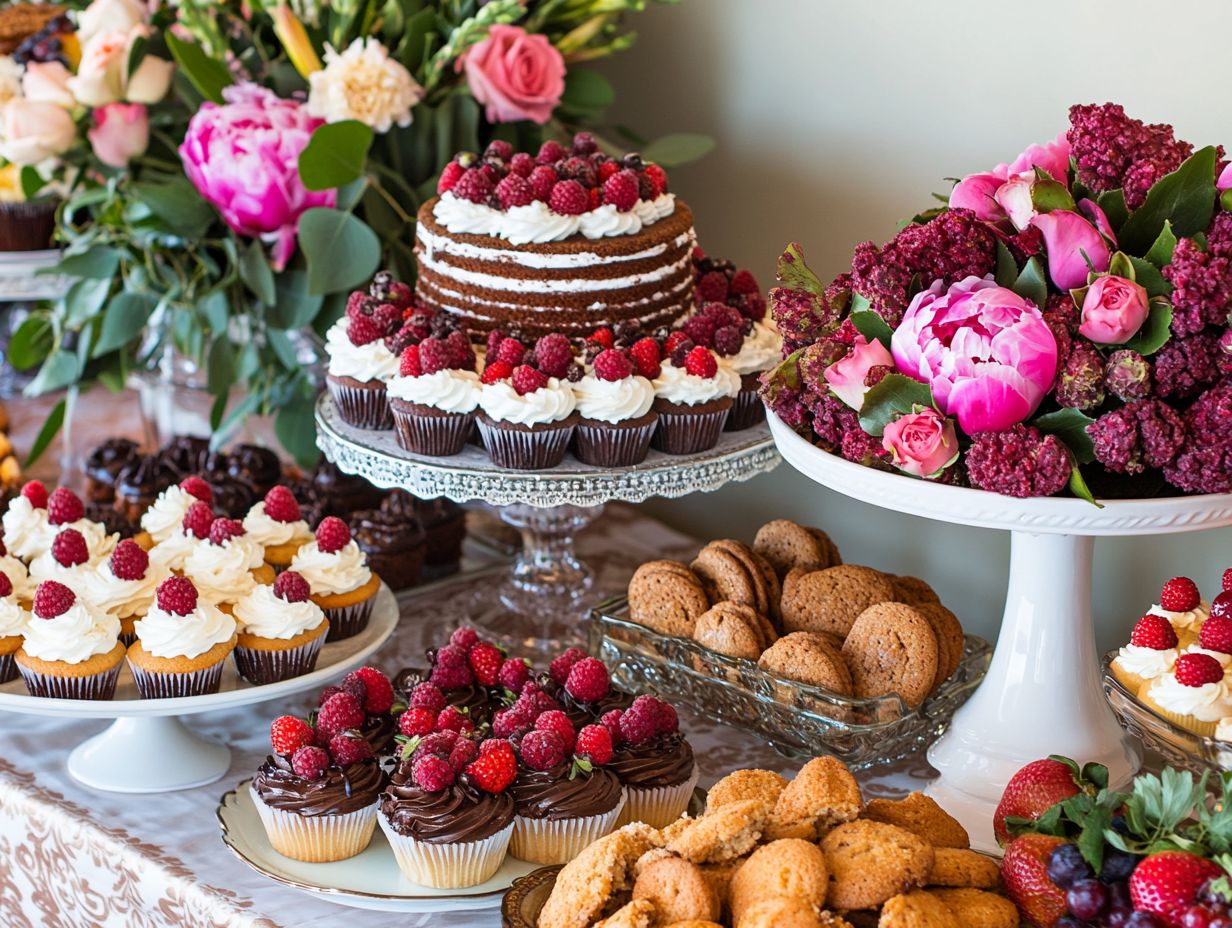
Setting up your dessert table is the crowning touch in creating a beautiful display that beckons guests to indulge in gluten-free delights.
An enticing dessert display includes both great treats and careful organization. The key is in the thoughtful organization of the space. Consider utilizing varying heights by incorporating stands or pedestals. These can add depth to your arrangement and draw attention to your gluten-free cakes and pastries.
Incorporate fresh fruit and orange slices for vibrant decoration. Harmonize colors by choosing desserts with a complementary palette, ensuring that each item stands out while contributing to a cohesive look that s pleasing to the eye.
Don t forget to include label cards indicating each dessert’s flavor or ingredients. This thoughtful touch allows guests with dietary preferences to feel included in the experience. Lastly, consider using elegant table linens and decorative utensils that align with the overall theme, making every detail count in achieving a delightful and memorable presentation.
1. Label All Desserts with Ingredients
Labeling all desserts with their ingredients is essential for creating a gluten-free dessert table, as it gives you and your guests the power to make informed choices about what can be safely enjoyed. Clear labels should indicate which items are gluten-free and highlight any potential allergens, ensuring transparency and safety for everyone involved.
This simple yet effective practice enhances the dining experience and cultivates trust with your guests, demonstrating that you genuinely care about their dietary needs.
Providing detailed information about the sources of ingredients can further bolster the confidence of those with food sensitivities. Descriptive labels can also include notes about the preparation methods, such as whether cross-contamination occurs, which is crucial for guests with severe allergies. (Cross-contamination occurs when gluten-free items come into contact with gluten-containing foods.)
Utilizing clear, legible fonts and eye-catching colors on the labels will make it easier for your patrons to quickly scan and find the perfect dessert that meets their needs. Highlight desserts such as mini heart-shaped cookies or chocolate angels for special events.
By prioritizing these effective communication practices, you can ensure a safe and enjoyable experience, reinforcing the importance of guest care and satisfaction in any culinary setting.
Get creative and make your dessert table the highlight of the event!
2. Keep Gluten-Free Desserts Separate from Non-Gluten-Free Desserts
Keeping gluten-free desserts separate from their non-gluten-free counterparts is crucial for preventing cross-contamination. This ensures your guests can enjoy their treats with peace of mind. Consider using distinct serving trays or designating a separate area on the dessert table exclusively for gluten-free options, clearly marked to eliminate any confusion.
This thoughtful practice not only protects those with dietary restrictions, such as gluten intolerance or allergies, but also fosters an inclusive atmosphere at your event. Use specialty stores and online retailers to find unique gluten-free ingredients.
To enhance safety, use different utensils and ensure that hands are washed thoroughly before handling gluten-free items. Educating your staff about the significance of these precautions can greatly help; they must understand that even the tiniest amount of gluten can impact sensitive individuals.
Utilizing signage that clearly labels gluten-free items while highlighting their allergen-free status provides further reassurance to your guests. Use serving trays and baking dishes specifically designated for gluten-free items.
By offering a variety of gluten-free desserts, including easy-to-make recipes such as graham cracker cookies and fruit sorbets, you ensure that everyone finds a delightful option, reinforcing your commitment to accommodating diverse dietary needs.
3. Offer a Variety of Flavors and Options
Offering a delightful array of flavors and options on your gluten-free dessert table is vital for making your dessert table unforgettable. This caters to the diverse palates and preferences of your guests, transforming the experience into one that everyone can savor.
Imagine presenting an assortment of desserts, from indulgent chocolate treats to vibrant fruity options featuring seasonal fruits. Include rich cookie bars that cater to various tastes, and consider desserts such as banana pudding, pavlova, and Rocky Mountains to delight your guests.
This diversity not only elevates the visual appeal of your table but also guarantees that each guest discovers something to adore.
Introduce intriguing flavor combinations, such as the delightful contrast of salted caramel with dark chocolate or the refreshing zest of lemon paired with a hint of lavender these can truly elevate the dessert experience to new heights. Integrate whipped cream and chocolate ganache for added indulgence.
Don t forget about those who lean towards lighter fare. Incorporating panna cotta infused with coconut milk or a luscious mousse made from avocados will resonate with health-conscious attendees. Light and healthy dessert options, such as fresh fruit and cranberries, will cater to various preferences.
Ultimately, crafting a well-rounded dessert menu delights the senses and fosters a sense of inclusivity. This ensures that every guest feels valued and thoroughly satisfied with their sweet selections, including delicious gluten-free options.
Start gathering your ingredients today for a dessert table that everyone will rave about!
4. Consider Cross-Contamination and Allergies
Considering cross-contamination and allergies when preparing a gluten-free dessert table is essential for ensuring the safety and enjoyment of all your guests.
Follow strict kitchen rules to prevent gluten-containing ingredients from mingling with gluten-free treats. Clearly communicating with your guests about potential allergens is just as important. This meticulous attention to detail allows everyone to indulge in the desserts with peace of mind, cultivating a welcoming atmosphere perfect for family gatherings and wedding receptions.
To elevate food safety further, train your staff to use separate utensils and equipment for gluten-free items. Designating specific areas for preparation and serving will help eliminate risks. Labeling each dessert with its ingredients empowers your guests to make informed choices, enhancing their overall comfort.
Consider using serving trays and dessert boards to clearly differentiate between gluten-free and other desserts. Utilizing color-coded systems for plates and serving utensils can reinforce these practices, making it effortless to identify gluten-free options.
By establishing these comprehensive measures, you can shift the focus to creating an inviting environment where guests can truly relish their treats without a hint of concern. Delight your guests with vibrant desserts like mini cheesecake bites, no-flour chocolate treats, and homemade vanilla pudding!
Frequently Asked Questions
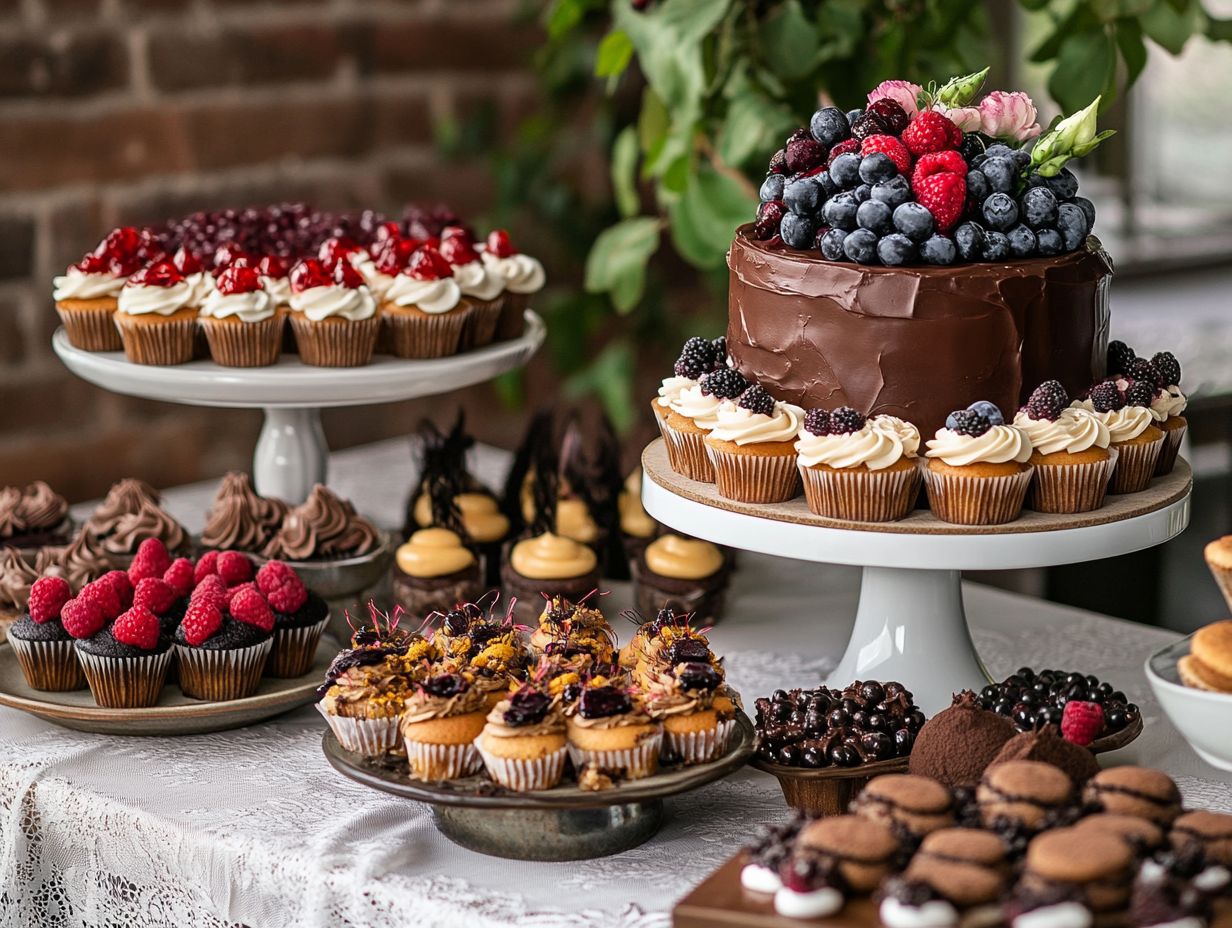
What is a gluten-free dessert table?
A gluten-free dessert table is a selection of desserts that are free of gluten, a protein found in wheat, barley, and rye. This type of dessert table is suitable for those who have celiac disease or gluten intolerance.
How do I start planning for a gluten-free dessert table?
The first step is to determine your guest list and their dietary restrictions. Once you know how many guests require gluten-free options, you can start selecting desserts and creating a menu.
What types of desserts can I include in a gluten-free dessert table?
There are many delicious gluten-free dessert options, such as flourless chocolate cake, macarons, fruit tarts, and meringues. You can also make gluten-free versions of traditional desserts, like brownies or cookies, or try popular dessert recipes like Magic Cookie Bars and peanut butter cookies.
Where can I find gluten-free ingredients for my desserts?
You can find gluten-free ingredients at most grocery stores, health food stores, or online. Look for products that are labeled “gluten-free” or check the ingredient list for any gluten-containing grains. Popular ingredients include gluten-free flour, baking dishes, sweetened condensed milk, and chocolate chips.
How can I make sure my gluten-free dessert table is safe for those with celiac disease?
Cross-contamination is a concern when creating a gluten-free dessert table. Use separate utensils, bowls, and baking sheets for gluten-free desserts. Also, be careful when serving and plating the desserts to avoid any contact with gluten-containing foods. Clearly label desserts like Eton Mess, banana pudding, fresh fruit tarts, and chocolate mousse.
Can I make my whole dessert table gluten-free?
Yes, you can make your entire dessert table gluten-free. This is a great option for those who have celiac disease or gluten intolerance to ensure that they can enjoy all the treats without worry. Include a variety of sweet treats like cookie bars, peach cobbler, and pavlova. Just be sure to inform your guests of the gluten-free options available.
Consider trying your hand at creating your own gluten-free dessert table and share your experiences with others!

